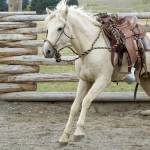Concussion in Movement of the Horse

Concussion is the force sent vertically up the leg each time a horse’s hoof strikes the ground. Concussion is a major factor in lameness.
Factors that affect the concussive force on the horse’s legs are:
- The angle, surface, and hardness of the ground on which the horse is travelling.
- Overall fitness. The more fit the horse is, the more efficiently its body will cope with the effects of concussion.
- The horse’s conformation. The closer the horse is to proper conformation and ideal joint angles, the better it will absorb concussion.
The horse has several mechanisms to counteract the effects of concussion. Among these are the high moisture content of the hoof and the elasticity of the hoof wall, collateral cartilages, digital cushion, and frog, all of which aid in absorbing concussion.
When the hoof first strikes the ground, the joints above the fetlock are slightly bent, which helps to absorb some of the shock. The muscles, tendons and ligaments act like springs, absorbing the concussion of impact by allowing some flexion of the knee and elbow (hock and stifle in the rear legs) and helping to push the weight of the horse back up again.
The small bones of the knee (carpus) are spongy with small spaces within the bones, as well as between the bones, to aid in absorbing concussion.
Instead of a collarbone, the horse has what is termed a “thoracic sling.” The front legs are not attached to the body by a joint, but instead are connected by tendons and ligaments, an arrangement that allows the horse’s body to dip and spring during motion. Again, this assists absorption of concussion and reduces the shock waves going along the spine.
There is less concussive force on the hind limbs than the front limbs because they take less of the total weight of the horse. However, the hind limbs are joined to the body by a joint (hip joint), so any shock will travel to the spine. The cartilaginous disks between the vertebrae help to absorb this concussion.
The hock also assists in the shock absorption process. As with the knee, it is made up of small bones set on top of each other. However, if the angle of the hock is too straight, then the joint will have only a limited ability to reduce the shock.
When the horse is moving in a gallop, which is a four-beat gait, the leading leg is subject to most concussion. When the horse starts to fatigue, stride frequency decreases. The “out of phase” pair of legs comes into phase again (four beats become three), more stress is placed on the leading leg than before because of the horse bobbing up and down, and the horse begins to change the lead leg every few strides. This is why the leading leg is most susceptible to injury in a racehorse towards the end of the race.
This article is adapted, with permission, from Horse Sense—The Guide to Horse Care in Australia and New Zealand, second edition (2004).








